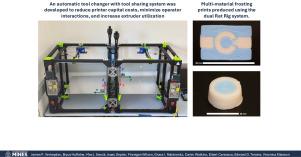Tool changing and tool sharing system for interconnected multi-material direct ink write 3D printers
IF 2.1
Q3 ENGINEERING, ELECTRICAL & ELECTRONIC
引用次数: 0
Abstract
Direct ink write (DIW) is a material extrusion additive manufacturing technique where a flowable liquid or semi-solid ink is selectively deposited through a nozzle onto a build surface. DIW can be leveraged to print a wide range of multi-material components with unique geometries, which would otherwise be challenging to produce with traditional manufacturing techniques. However, despite their unique capabilities, DIW extruders are costly to purchase and labor intensive to clean, limiting widespread adoption. To address these challenges, an automatic tool changer with tool sharing system was developed to reduce printer capital costs, minimize operator interactions, and increase extruder utilization. Unlike conventional tool changers popular with fused filament fabrication (FFF) printers, which allows a single printer to swap between multiple tools, this novel tool sharing system enables tool sharing and coordination between two adjacent printers. By effectively halving the total number of extruders and associated cleaning operations, DIW capabilities are greatly improved, increasing production, lowering system cost, and minimizing operator involvement. The hardware consists of a tool changing mechanism, post processor to insert tool exchange G-code, and software to coordinate tool sharing between printers, enabling tool changing and tool sharing between two adjacent printers.

互连多材料直接墨写3D打印机换刀及刀具共享系统
直接墨水写入(DIW)是一种材料挤压增材制造技术,其中可流动的液体或半固体墨水通过喷嘴选择性沉积在构建表面上。DIW可以用来打印各种具有独特几何形状的多材料部件,否则用传统制造技术生产是具有挑战性的。然而,尽管具有独特的功能,DIW挤出机购买成本高,清洁劳动密集,限制了广泛采用。为了应对这些挑战,开发了一种带有工具共享系统的自动换刀器,以降低打印机的资本成本,最大限度地减少操作人员的互动,并提高挤出机的利用率。与传统的熔丝制造(FFF)打印机的工具更换器不同,这种新型的工具共享系统可以在两台相邻的打印机之间实现工具共享和协调。通过将挤出机和相关清洗操作的总数有效地减少一半,DIW的能力得到了极大的提高,提高了产量,降低了系统成本,并最大限度地减少了操作人员的参与。硬件包括换刀机构、插入换刀g码的后置处理器和协调打印机之间共享刀具的软件,实现相邻两台打印机之间的换刀和共享刀具。
本文章由计算机程序翻译,如有差异,请以英文原文为准。
求助全文
约1分钟内获得全文
求助全文
来源期刊

HardwareX
Engineering-Industrial and Manufacturing Engineering
CiteScore
4.10
自引率
18.20%
发文量
124
审稿时长
24 weeks
期刊介绍:
HardwareX is an open access journal established to promote free and open source designing, building and customizing of scientific infrastructure (hardware). HardwareX aims to recognize researchers for the time and effort in developing scientific infrastructure while providing end-users with sufficient information to replicate and validate the advances presented. HardwareX is open to input from all scientific, technological and medical disciplines. Scientific infrastructure will be interpreted in the broadest sense. Including hardware modifications to existing infrastructure, sensors and tools that perform measurements and other functions outside of the traditional lab setting (such as wearables, air/water quality sensors, and low cost alternatives to existing tools), and the creation of wholly new tools for either standard or novel laboratory tasks. Authors are encouraged to submit hardware developments that address all aspects of science, not only the final measurement, for example, enhancements in sample preparation and handling, user safety, and quality control. The use of distributed digital manufacturing strategies (e.g. 3-D printing) is encouraged. All designs must be submitted under an open hardware license.
 求助内容:
求助内容: 应助结果提醒方式:
应助结果提醒方式:


